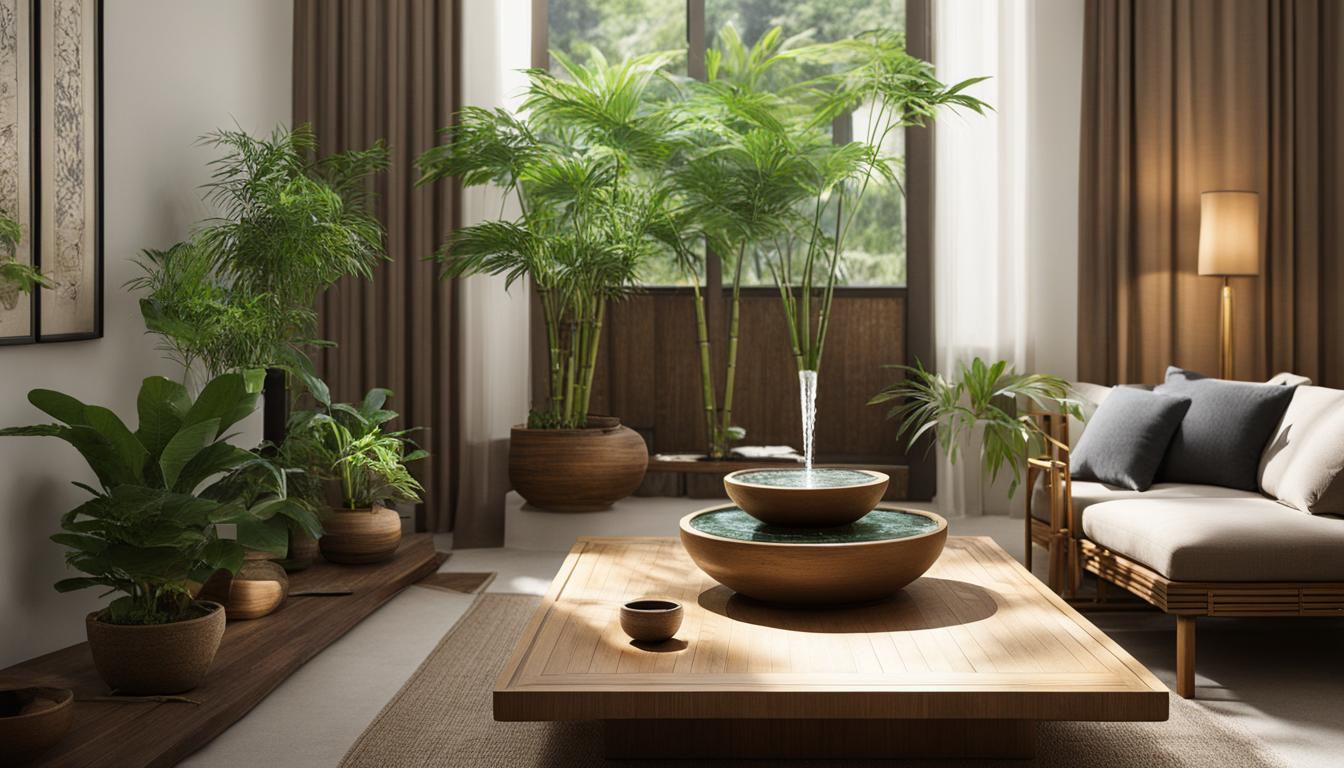Are you seeking to create a harmonious atmosphere in your home? If so, then feng shui bagua decorating ideas may be just what you need. By using the bagua map, you can enhance the energy flow in your living space and create a more balanced environment. Whether you’re looking to revamp your living room, bedroom, or entire home, feng shui offers a myriad of decorating tips and principles to help you achieve your goals.
Key Takeaways:
- Feng shui bagua decorating ideas can help you create a harmonious atmosphere in your home.
- The bagua map provides a framework for enhancing the energy flow in your living space.
- Feng shui offers numerous decorating tips and principles for revamping your living room, bedroom, and entire home.
- By using colors, natural elements, and other feng shui enhancements, you can create a more balanced and positive environment.
- Feng shui is an ongoing process, requiring regular adjustments and maintenance to maintain a harmonious atmosphere.
Understanding the Bagua Map for Decorating
Before we delve into specific feng shui decorating principles and interior design tips, it is crucial to understand the bagua map and how it guides your decor choices. The bagua is an energy map that represents different areas of your life, such as love, wealth, and health.
The bagua is divided into nine areas that correspond to specific life aspects, as shown in the table below:
| Bagua Area | Life Aspect |
|---|---|
| North | Career, Path in Life |
| Northeast | Spiritual Growth |
| East | Health, Family |
| Southeast | Wealth, Abundance |
| South | Fame, Reputation |
| Southwest | Love, Marriage, Relationships |
| West | Creativity, Children |
| Northwest | Helpful People, Travel |
| Center | Health, Harmony, Balance |
To use the bagua map for decorating, align the bottom of the map with the wall that contains the main entrance to the room. The different areas of the bagua map will correspond to different areas of your living space.
For example, if the north area of the bagua map corresponds to your career, consider placing decor elements in this area that reflect your professional goals and aspirations. Alternatively, if the southwest area of the bagua is associated with relationships, focus on incorporating decor elements that enhance your personal relationships.
Applying the Bagua Map in Your Home
Applying the principles of the bagua map to your home decor can help create balance and harmony in your living space. Consider the following tips:
- Use color to enhance the energy of specific bagua areas. For example, use greens and blues in the east area for health and family, and reds and purples in the southeast area for wealth and abundance.
- Place decor elements that correspond to specific bagua areas. For example, place a water feature in the north area for career success, and a plant or flowers in the southwest area for love and relationships.
- Choose artwork that reflects your intentions and goals for specific bagua areas. For example, hang a landscape painting in the northwest area for helpful people and travel, and a family photo in the east area for health and family.
By understanding the principles of the bagua map, you can create a harmonious and balanced living space that supports your goals and aspirations.
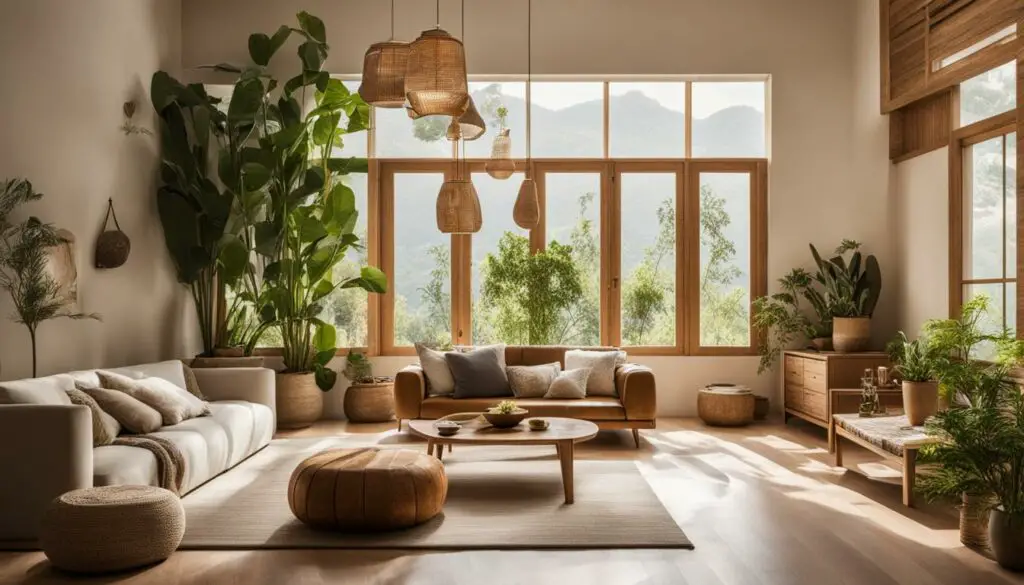
Feng Shui Decorating Tips for the Living Room
The living room is the hub of your home, where you relax, entertain, and spend quality time with your family and friends. By incorporating feng shui principles and using specific decor choices, you can create a harmonious and inviting space.
1. Choose Soothing Colors
Start by choosing a color palette that promotes relaxation and calmness. Soft, muted colors like beige, gray, and blue are ideal for creating a serene atmosphere in your living room. Avoid bright and bold colors, which can be too stimulating and overpowering.
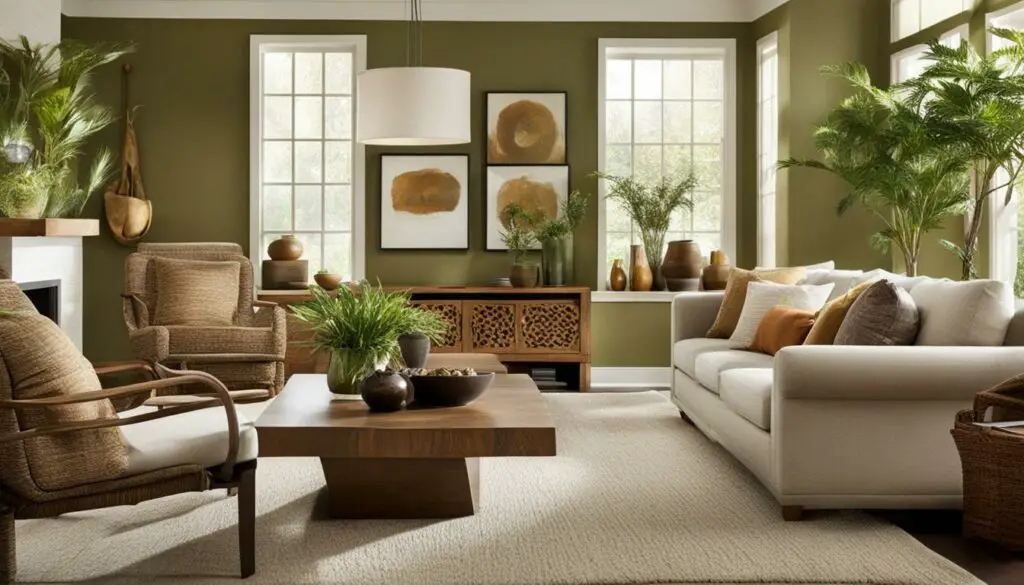
2. Optimize Furniture Placement
The way you arrange your furniture can significantly impact the energy flow in your living room. Arrange your furniture in a way that promotes conversation and relaxation, with comfortable seating and an unobstructed flow of movement. Avoid cluttering the space with too much furniture.
3. Incorporate Natural Elements
Integrating natural elements into your living room decor can help create a peaceful and harmonious environment. Consider adding plants, flowers, or a water feature to bring the energy of nature into your space.
4. Use Lighting to Enhance the Mood
Lighting can influence the mood and energy of your living room. Choose soft, warm lighting to create a cozy and relaxing atmosphere. Avoid harsh overhead lighting and opt for lamps or dimmer switches instead.
5. Display Meaningful Artwork
Artwork can be a powerful feng shui enhancement in your living room. Choose artwork that evokes positive emotions and aligns with your intentions. Display artwork in a central location where it can be easily seen and appreciated.
6. Keep the Space Clutter-Free
Clutter can disrupt the flow of energy in your living room. Keep the space organized and clutter-free by regularly decluttering and organizing. Store items out of sight in cabinets or drawers to create a peaceful and harmonious environment.
By implementing these feng shui living room ideas and incorporating specific feng shui colors for home, you can create a calming and harmonious space where you can relax and recharge. Start applying these tips today and transform your living room into a serene oasis.
Feng Shui Bedroom Decor
Your bedroom is a space for rest and rejuvenation, and it’s essential to create a calming and relaxing atmosphere that promotes peaceful sleep. Feng shui decorating principles can help you achieve a harmonious and balanced bedroom that supports your well-being. Follow these feng shui bedroom decor tips to create a soothing sanctuary:
- Choose a calming color palette: Soft, muted colors such as pastels, earthy neutrals, and cool blues can help promote relaxation.
- Avoid clutter: Keep your bedroom tidy and free from clutter to promote positive energy flow.
- Position your bed strategically: Place your bed in the “commanding position,” where you can see the door but are not directly in line with it. Avoid placing your bed under a window or directly facing a door.
Incorporating feng shui elements into your bedroom decor can further enhance the energy flow and promote restful sleep. Consider adding these elements:
| Feng Shui Element | Description | Example |
|---|---|---|
| Wood | Symbolizes growth, vitality, and new beginnings. | A potted plant or a wooden headboard. |
| Fire | Symbolizes passion and energy. Use sparingly in the bedroom. | A few candles or a small lamp. |
| Earth | Symbolizes stability and grounding. | A clay vase or a rock crystal lamp. |
| Metal | Symbolizes clarity and precision. Use sparingly in the bedroom. | A metal picture frame or a silver vase. |
| Water | Symbolizes flow and ease. Use sparingly in the bedroom. | A small tabletop fountain or a blue-hued painting. |
Lastly, incorporating elements from nature can further enhance feng shui bedroom decor. Using natural fibers for bedding and incorporating plants or flowers can bring tranquility and peace to the space.
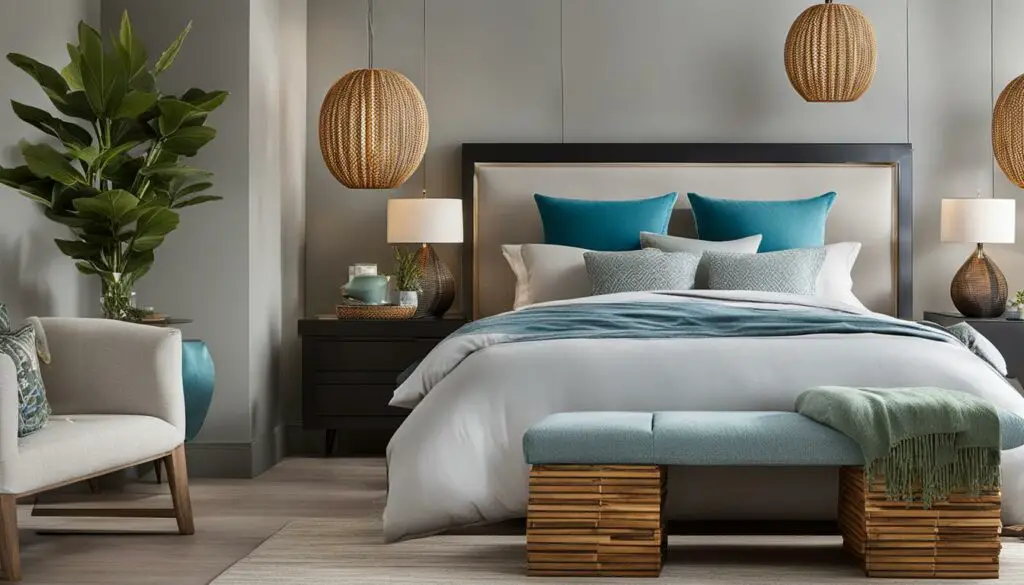
Using Colors to Create Positive Energy
Color is a powerful tool in feng shui decorating, and choosing the right colors for your space can greatly enhance the flow of positive energy. Each color has its own unique energy and can evoke specific emotions and associations. By incorporating the right colors into your decor, you can create a space that promotes balance and harmony.
Here are some feng shui color tips for different areas of the bagua map:
North Area
The north area of the bagua map is associated with career and success. Colors that are best suited for this area include black, blue, and white, which represent water and help to promote clarity and focus. Avoid using too many earth tones, such as brown or green, which can create stagnant energy.
South Area
The south area of the bagua map is associated with fame and reputation. Colors that are best suited for this area include red, orange, and yellow, which represent fire and help to promote passion and enthusiasm. Avoid using too many water or metal tones, such as blue or silver, which can extinguish the fiery energy.
East Area
The east area of the bagua map is associated with health and well-being. Colors that are best suited for this area include green and brown, which represent wood and help to promote growth and renewal. Avoid using too many metal colors, such as white or gray, which can deplete the wood energy.
West Area
The west area of the bagua map is associated with creativity and children. Colors that are best suited for this area include white, gray, and pastel colors. These colors represent metal and help to promote clarity and precision in creative endeavors. Avoid using too many fire colors, such as red or orange, which can create chaos and disrupt the calm energy.
Center Area
The center area of the bagua map is associated with health and well-being. Colors that are best suited for this area include yellow and earth tones, which represent stability and balance. Avoid using too many bright or bold colors, which can create excessive energy and disrupt the balance.
Remember, when choosing colors for your space, it’s important to consider the overall energy flow and balance. By incorporating a variety of colors from different elements, you can create a space that promotes harmony and positivity.
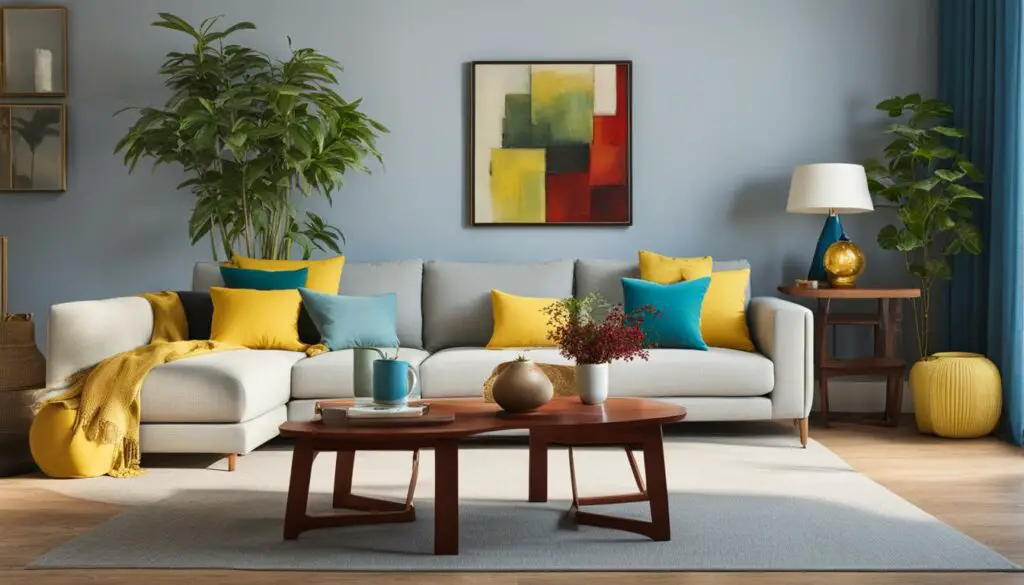
Using Colors to Create Positive Energy
Color is a fundamental element of feng shui home decorating. It can have a significant impact on the energy flow in your space, affecting your mood, emotions, and overall well-being. By understanding the principles of feng shui color theory, you can use color to create positive energy in your home.
The bagua map can guide you in choosing the right colors for each area of your home. For example:
| Bagua Area | Recommended Colors |
|---|---|
| Wealth | Green, purple, gold |
| Fame and Reputation | Red, orange, purple |
| Love and Relationships | Pink, red, white |
| Family | Green, brown |
| Health | Yellow, earth tones |
| Center | Yellow |
| Knowledge | Blue, green |
| Career | Black, navy blue |
| Helpful People and Travel | Silver, white, gray |
It’s essential to use the right shades and tones of each color, as different hues can create different energy vibrations. For example, bright red can create a lively and stimulating energy, while dark red can evoke a sense of drama or danger.
Consider the overall mood you want to create in each room and choose colors that align with that intention. For example, if you want to create a calm and peaceful bedroom, choose soft, soothing colors like blue or green.
When using color in your feng shui home decorating, consider the balance and harmony of the colors you choose. Too much of one color can create an imbalance, while a harmonious blend of colors can create a sense of unity and balance.
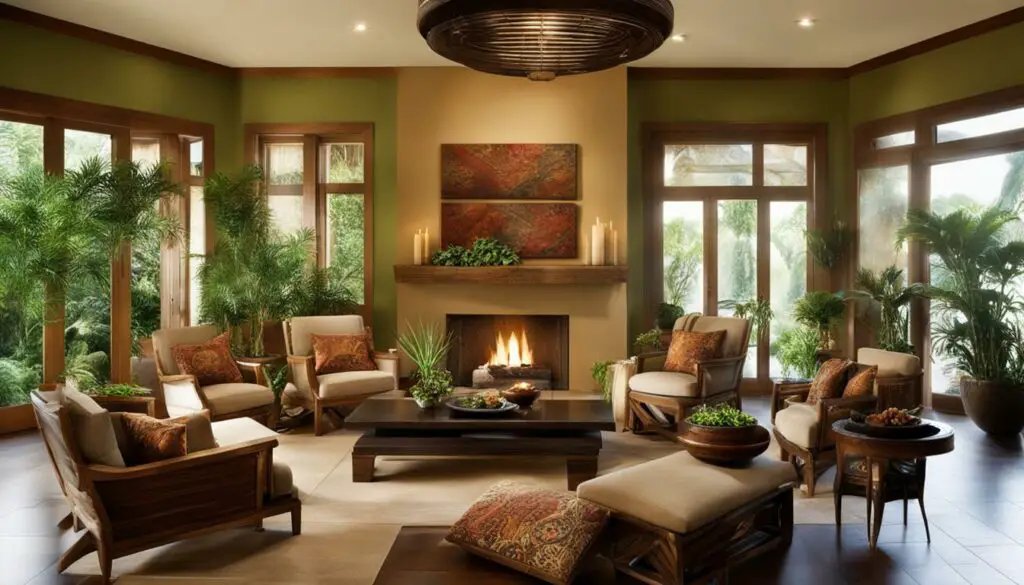
Feng Shui Decorating Tips: Clearing Clutter for Better Energy Flow
Clutter is a common problem that can disrupt the flow of energy in your home. It’s essential to declutter regularly to create a more harmonious environment and promote positive energy. Use these feng shui home decorating tips to help you clear out clutter and improve the energy flow in your space.
Identify Problem Areas
The first step in decluttering is to identify problem areas. Walk around your home and notice which areas feel cluttered or stagnant. Common problem areas include closets, cabinets, and shelves. Look for areas where items are piled high or where you tend to accumulate excess stuff.
Let Go of Unnecessary Items
Once you’ve identified problem areas, it’s time to let go of unnecessary items. Marie Kondo, a renowned decluttering expert, recommends asking yourself, “Does this item spark joy?” If the answer is no, it’s time to let it go. You can donate, sell, or give away items that no longer serve you.
Organize Remaining Items
After letting go of unnecessary items, it’s time to organize what remains. Use storage solutions like baskets, bins, and shelves to keep items in their designated places. Make sure everything has a specific home so that you can easily find and access what you need.
Avoid Overcrowding Spaces
It’s essential to avoid overcrowding spaces with too many items. Keep surfaces clear and leave ample open space for energy to flow freely. Remember, less is often more in feng shui home decorating.
Use Feng Shui Principles for Arranging Furniture
The placement of furniture can significantly impact the flow of energy in your space. Use feng shui principles to arrange furniture in a way that promotes positive energy. For example, avoid placing furniture with its back to the door, which can create stagnant energy.
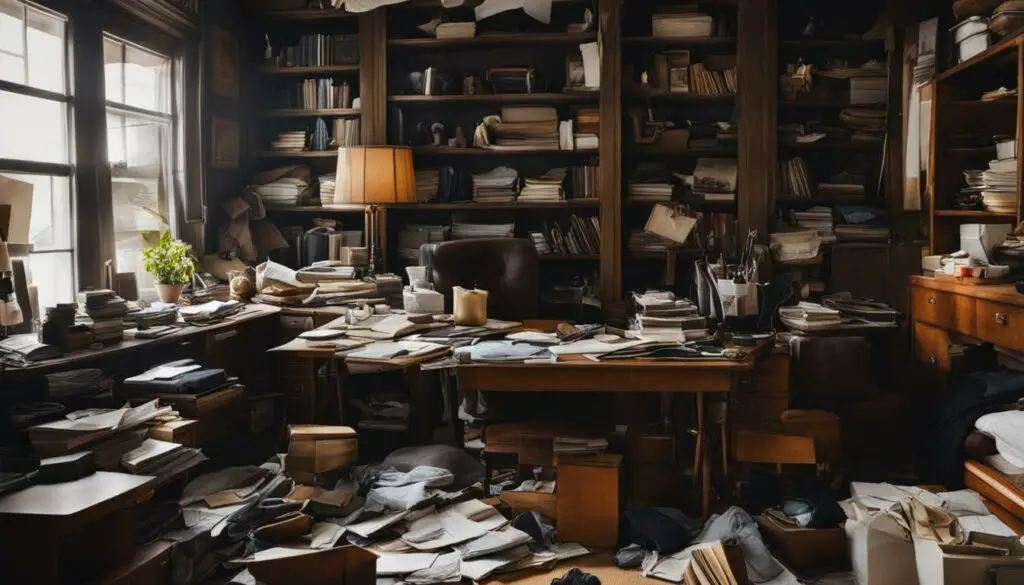
“Clutter is not just physical stuff. It’s old ideas, toxic relationships, and bad habits. Clutter is anything that does not support your better self.” – Eleanor Brown
By decluttering and organizing your space, you can create a more harmonious environment and promote positive energy flow. Use these feng shui decorating tips to help you clear out clutter and create a serene oasis in your home.
Balancing Yin and Yang Energies in Your Home
In feng shui, balancing yin and yang energies is essential for creating a harmonious environment. Yin represents passive, calm, and cool energy, while yang represents active, vibrant, and warm energy. Both energies are necessary for balance and well-being in your home.
To achieve a balance between yin and yang energies, start by identifying the areas in your home that feel either too yin or too yang. For example, a room with dark colors, minimal light, and little movement may have too much yin energy, while a room with bright colors, loud noise, and high activity may have too much yang energy.
To balance the yin and yang energies in a room with too much yin, consider adding elements of yang energy. This can be achieved through the use of brighter colors, more light, and the incorporation of movement, such as a ceiling fan or a water feature.
On the other hand, balancing a room with too much yang energy may require the addition of yin elements, such as soft lighting, calming colors, and soothing textures.
It’s important to note that the balance between yin and yang energies can vary depending on the room’s function. For example, a bedroom should have more yin energy, promoting relaxation and rest, while a kitchen should have more yang energy, promoting activity and energy.
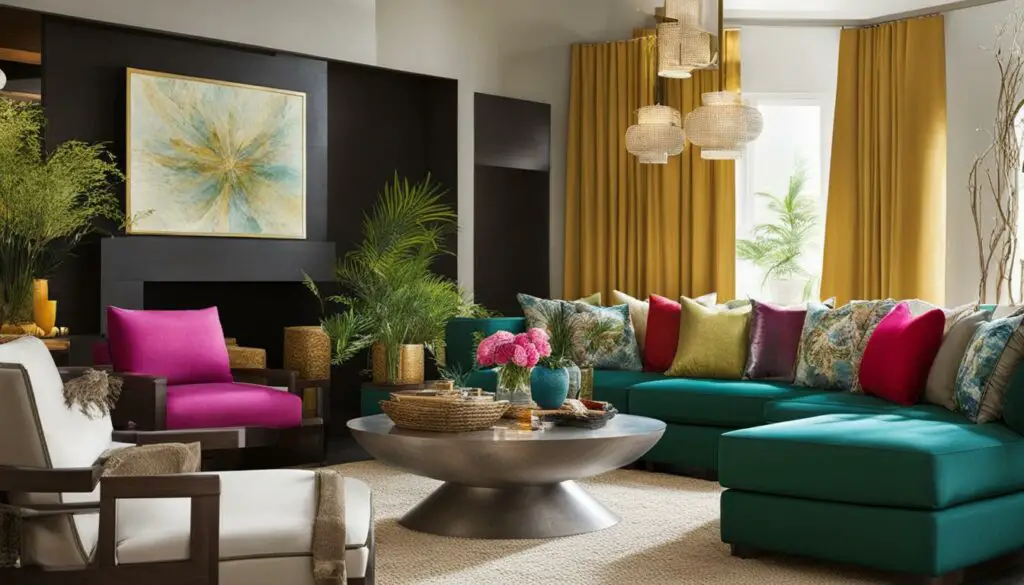
Yin and Yang Elements
The five feng shui elements – wood, fire, earth, metal, and water – are also associated with yin and yang energies. Wood, fire, and metal are considered yang elements, while earth and water are considered yin elements.
To balance the yin and yang energies in your home, consider incorporating a variety of the five elements. For example, a room with too much yang energy could benefit from the addition of earth and water elements, while a room with too much yin energy could benefit from the addition of wood, fire, or metal elements.
The Importance of Balance
By achieving a balance between yin and yang energies in your home, you can create a sense of harmony and well-being. Too much of either energy can lead to feelings of discomfort or unease, while a balance of both energies can support your physical, emotional, and spiritual health.
Remember to consider the balance of yin and yang energies in each room of your home and adjust your decor accordingly. With a little feng shui know-how, you can create a harmonious and balanced environment that supports your well-being and goals.
Enhancing the Energy Flow with Mirrors and Lighting
Mirrors and lighting are essential elements in feng shui home decorating. They can be used to enhance the energy flow in your space and create a sense of expansion. Mirrors reflect light and energy, while lighting illuminates and enhances specific areas.
Using mirrors strategically can help increase the flow of energy in your home. Place mirrors in areas where there is limited natural light or where you want to create the illusion of more space. However, make sure they don’t reflect cluttered or negative areas.
Lighting is also an important aspect of feng shui home decorating. Proper lighting can affect your mood and energy levels. Use a combination of natural and artificial light sources to create a balanced and harmonious environment.
Tip: Use full-spectrum bulbs to mimic natural daylight and promote a sense of well-being.
Consider the placement of lighting fixtures in each room. Overhead lighting should be bright and evenly distributed, while lamps can be used to create a cozy and intimate atmosphere in specific areas.
Using Mirrors and Lighting for Specific Areas
Using mirrors and lighting in specific areas of your home can have a significant impact on the overall energy flow. Here are some feng shui tips for incorporating mirrors and lighting in specific areas:
| Area | Mirrors | Lighting |
|---|---|---|
| Bathroom | Place a mirror on the outside of the bathroom door to deflect negative energy. Avoid mirrors reflecting the toilet. | Use bright and even lighting to promote cleanliness and clarity. |
| Entryway | Place a mirror near the front door to reflect positive energy into your home. Avoid mirrors reflecting the front door. | Use warm and welcoming lighting to create a sense of invitation and comfort. |
| Kitchen | Place a mirror behind the stove to expand the energy of abundance and wealth. Avoid mirrors reflecting the sink or trash. | Use bright and natural lighting to promote health and vitality. |
| Bedroom | Avoid mirrors facing the bed. Place mirrors in a position where they reflect a lovely view or artwork. | Use soft lighting to create a calming and relaxing atmosphere. |

Remember to use mirrors and lighting in moderation. Too many mirrors or bright lights can be overwhelming and have a negative impact on the energy flow in your home. Use them wisely and intentionally to create a balanced and harmonious environment.
Creating a Sacred Space with Altars and Crystals
Altars and crystals are popular feng shui decor choices that can enhance the positive energy in your home. Altars are used to create a sacred space for meditation, prayer, or spiritual practice. Crystals, on the other hand, are believed to have unique vibrations and properties that can help balance and harmonize the energy in your space. Here are some feng shui decorating tips for using altars and crystals in your home:
Creating an altar
To create an altar, choose a quiet and peaceful spot in your home where you can sit or stand comfortably. You can use a small table, shelf, or even a windowsill as your altar. The placement of your altar should correspond to the bagua map area that you want to enhance. For example, if you want to improve your career prospects, place your altar in the north area of your home.
Next, choose objects to place on your altar that have spiritual or personal significance to you, such as statues, candles, photographs, or sacred texts. You can also incorporate natural elements, such as plants or crystals, into your altar as well.
When arranging your altar, use feng shui principles to create a balanced and harmonious layout. Avoid clutter and keep your altar clean and well-maintained. Use a soft cloth to dust your altar regularly and replace any candles or flowers that have wilted.
Using crystals
Crystals come in various shapes, sizes, and colors, and each has unique properties and energies. When choosing crystals for your feng shui decor, consider their color and the area of the bagua map where you want to enhance energy. Here are some examples:
| Crystal | Color | Properties | Bagua map area |
|---|---|---|---|
| Amethyst | Purple | Calming, enhances spiritual awareness | Southwest (love and relationships), West (creativity) |
| Citrine | Yellow | Uplifting, energizing, attracts abundance | Southeast (wealth and abundance) |
| Rose quartz | Pink | Emotional healing, love, harmony | Southwest (love and relationships) |
You can place crystals in different areas of your home to enhance positive energy. For example, you can place a citrine crystal in your wealth corner to attract abundance or a rose quartz crystal in your bedroom to improve your love life.
Remember to cleanse your crystals regularly to maintain their energy. You can use smoke, water, or other cleansing methods to purify your crystals and remove any negative or stagnant energy.

Tip: When using altars and crystals in your feng shui decor, focus on your intentions and the energy you want to cultivate in your space. Choose objects that resonate with you personally and create a spiritual and uplifting environment in your home.
By incorporating altars and crystals into your feng shui decor, you can create a sacred space that enhances positive energy and promotes spiritual growth and well-being. Experiment with different crystals and altar arrangements to find what works best for you and your space.
Embracing the Five Feng Shui Elements
Understanding and incorporating the five feng shui elements – wood, fire, earth, metal, and water – is an essential part of creating a harmonious and balanced space. Each element has unique qualities and associations that can help enhance the energy flow in different areas of your home. Let’s explore how you can bring each of these elements into your feng shui home decorating:
Wood
Wood is associated with growth, vitality, and abundance. To incorporate the wood element into your decor, consider adding plants, flowers, or wooden furniture. The color green is also linked with the wood element and can be added through accents like throw pillows or curtains.
Fire
Fire is a powerful element associated with passion, transformation, and creativity. In feng shui, fire is represented by the colors red, orange, and yellow. Consider adding these hues through artwork, candles, or accent pillows. You can also opt for lighting that mimics the warmth and glow of fire.
Earth
The earth element is associated with stability, nourishment, and grounding. To incorporate this element into your decor, consider adding natural materials like stone, clay, or ceramics. The color yellow is also associated with the earth element and can be added through artwork or decor accents.
Metal
Metal is a strong and precise element associated with clarity, focus, and efficiency. Incorporate metal into your decor with metallic finishes, stainless steel appliances, or metal art pieces. The colors white and gray are also linked with the metal element and can be added through bedding or accent pieces.
Water
Water is a fluid and calming element associated with intuition, healing, and relaxation. To bring water into your decor, consider adding a water feature like a fountain or aquarium. The colors blue and black are also associated with the water element and can be added through bedding or decor accents.
By incorporating these feng shui elements into your decor, you can create a space that feels balanced, harmonious, and full of positive energy.

Applying Feng Shui Principles to Specific Areas
Now that you understand the basics of feng shui decoration and the bagua map, it’s time to apply these principles to specific areas of your home. By optimizing the energy flow in each area, you can create a more harmonious and balanced environment that supports your goals and well-being.
The Entrance
The entrance of your home is an essential area to focus on in feng shui. It’s the first impression of your space and sets the tone for the energy flow throughout the rest of your home. Make sure it’s well-lit, clutter-free, and welcoming. Consider adding a mirror to reflect the flow of energy and incorporating natural elements, such as plants or a water feature, to enhance positive energy.
The Kitchen
The kitchen is the heart of the home, where nourishment and abundance are created. In feng shui, it’s important to keep this area clean, organized, and well-lit to promote positive energy flow. Incorporate the fire element through the use of red or orange decor, but be sure to balance it out with other elements to create a harmonious atmosphere.
The Bathroom
Bathrooms can be challenging areas in feng shui due to their association with draining energy. Keep this area fresh and clean and avoid storing clutter here. Incorporate the water element through the use of blue or green decor and add natural elements, such as plants or crystals, to enhance positive energy flow.
The Home Office
The home office is where you focus on work and productivity, making it essential to optimize energy flow for maximum efficiency. Position your desk in a commanding position facing the door and avoid hanging shelves or cabinets above it. Incorporate the wood element through the use of desk accessories or plants to enhance creativity and clarity of thought.

Remember, every area of your home has its unique energy flow and corresponding feng shui principles. Applying these principles to each area can help you create a harmonious and balanced environment that supports your well-being and goals.
Harmonizing the Energy Flow with Furniture Placement
Furniture placement is a crucial factor in feng shui home decorating. By arranging furniture in a way that optimizes the flow of energy, you can create a harmonious environment that supports your well-being. Here are some feng shui principles to guide your furniture placement:
- Find the focal point. Every room should have a focal point, such as a fireplace or a window with a view. Arrange furniture in a way that emphasizes the focal point and creates a sense of balance.
- Avoid blocking pathways. Make sure there is enough space to move around the room without obstacles. This creates a sense of ease and flow, promoting positive energy.
- Use the bagua map. Refer to the bagua map when arranging furniture to ensure each area of the room corresponds with the appropriate area of the map.
- Create conversation areas. Arrange seating in a way that facilitates conversation and connection. This creates a sense of community and promotes positive energy exchange.
- Balance yin and yang. Strike a balance between feminine and masculine energies in the room by using a combination of soft and hard textures and shapes.
- Avoid sharp edges. Round out sharp edges and corners with plants or decorative objects to promote a sense of flow and harmony.
By following these feng shui principles, you can create a balanced and harmonious furniture arrangement that supports positive energy flow in your home.

Incorporating Feng Shui Artwork and Decorative Objects
Artwork and decorative objects can play a significant role in feng shui home decorating. They can evoke specific energies and emotions and enhance the positive flow of energy within your space. Whether you’re looking to create a calming and peaceful atmosphere or to energize a particular area of your home, incorporating feng shui artwork and decorative objects can help you achieve your goals.
Choosing Artwork for Feng Shui Home Decorating
When choosing artwork for feng shui home decorating, consider the following tips:
- Choose pieces that speak to you and make you feel happy and inspired.
- If you’re looking to create a calming atmosphere, opt for artwork with soothing colors and images, such as landscapes or abstract paintings.
- For energizing a particular area of your home, choose artwork with bold colors and dynamic images, such as animal prints or abstract geometric shapes.
- Consider the placement of the artwork according to the bagua map. For example, if you’re looking to enhance the energy flow in the love and relationships area, hang artwork with romantic imagery or in shades of pink or red.
Incorporating Decorative Objects for Feng Shui Home Decorating
Decorative objects can also enhance the positive flow of energy within your space. Consider the following tips when incorporating decorative objects for feng shui home decorating:
- Use decorative objects to create a focal point in a particular area of your home. For example, a beautiful crystal or statue on a shelf can draw attention to the wealth and abundance area.
- Incorporate objects made of natural materials, such as wood or stone, to bring a sense of grounding and connection to nature.
- Consider the symbolism of each object and how it aligns with your intentions. For example, a pair of dolphins can represent harmony and togetherness, making them an excellent choice for the love and relationships area.
- Group objects in odd numbers, such as 3 or 5, to create a sense of balance and harmony.

Incorporating feng shui artwork and decorative objects into your home decor can be a powerful way to enhance the energy flow in your space. By choosing pieces that align with your intentions and placement according to the bagua map, you can create a harmonious and uplifting environment that supports your well-being and goals.
Maintaining a Harmonious Environment
Congratulations! You have transformed your space into a beautiful and balanced sanctuary with the help of feng shui decorating ideas. But how can you maintain this positive energy flow over time?
One key to maintaining a harmonious environment is to regularly refresh and adjust your feng shui decor. Our lives are constantly changing, and our homes should reflect these changes. As you evolve and grow, so should your space.
Here are some tips for maintaining a harmonious environment:
- Regularly declutter: As we accumulate possessions, clutter can quickly build up and disrupt the flow of energy in our space. Regular decluttering can help maintain a clear and open energy flow.
- Adjust decor seasonally: Just as our wardrobes evolve with the seasons, so should our home decor. Updating your decor seasonally can help keep your space feeling fresh and revitalized.
- Consider the bagua map: As you make changes to your decor, continue to refer to the bagua map to ensure that each area of your home is aligned with your intentions and goals.
Remember that maintaining a harmonious environment is an ongoing process. By staying mindful and intentional with your feng shui home decorating, you can continue to cultivate positive energy and support your well-being.
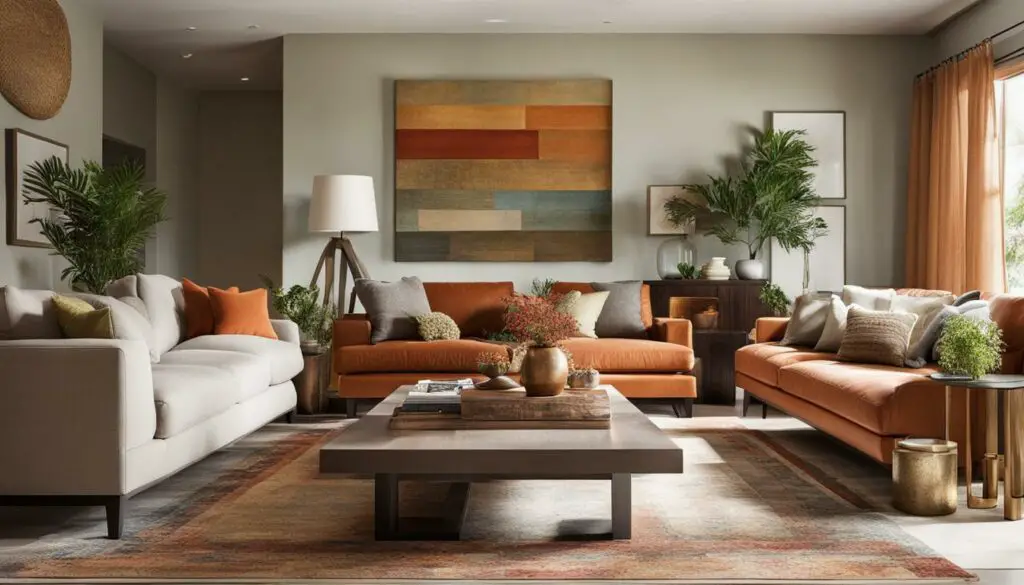
Conclusion
Creating a harmonious environment in your home is essential for your well-being and happiness. By applying feng shui bagua decorating ideas, you can transform your space into a peaceful, balanced, and inviting sanctuary.
Remember, feng shui is not just about decorating your home – it’s about creating an intentional and mindful space that supports your goals and aspirations. By understanding the principles of feng shui and incorporating specific decor choices, you can enhance the energy flow in your home and create a positive and uplifting environment.
Start Small and Build
Implementing all the feng shui bagua decorating ideas at once might seem overwhelming. Instead, start small and build your way up. Begin with the areas of your home that need the most attention, and gradually apply more feng shui principles throughout your space.
Stay Mindful and Open
To truly benefit from feng shui bagua decorating ideas, it’s essential to stay mindful and open. Pay attention to how your home feels and adjust your decor choices accordingly. Stay open to new ideas and opportunities to enhance the energy flow in your space.
Remember, feng shui bagua decorating ideas are not set in stone – they are adaptable and flexible. Use them as a guide to create a space that feels right for you and supports your well-being and goals.
So go ahead and start implementing feng shui bagua decorating ideas in your home today. Your space will thank you with positive energy, balance, and harmony!
FAQ
What is feng shui bagua decorating?
Feng shui bagua decorating is the practice of using the bagua map, a tool in feng shui, to enhance the energy flow in your home through specific decor choices. It involves arranging furniture, selecting colors, and incorporating natural elements to create balance and harmony.
How can the bagua map guide my decorating choices?
The bagua map is a guide used in feng shui to divide your space into different areas, each corresponding to a specific aspect of your life. By understanding the bagua map, you can align your decor choices with the energies associated with each area to create a more harmonious environment.
What are some feng shui decorating tips for the living room?
In the living room, it’s important to choose colors that promote relaxation and conversation. Placing furniture in a balanced and inviting arrangement can also enhance the energy flow. Additionally, selecting artwork that brings joy and incorporating natural elements like plants can create a harmonious space.
How can I enhance bedroom harmony with feng shui decor?
To create a peaceful bedroom, consider using soothing colors like soft blues or earth tones. Positioning the bed in a commanding position and balancing the elements in the room can also promote a sense of tranquility. Incorporating soft lighting and removing clutter can further enhance the energy flow.
How do colors affect feng shui decorating?
Colors have a significant impact on feng shui decorating as they can evoke different energies. For example, warm colors like red and orange are associated with passion and vitality, while cool colors like blue and green promote calmness and tranquility. By understanding the energy of colors, you can choose the right hues for each area of the bagua map.
How can I incorporate natural elements into my feng shui decor?
You can bring the power of nature into your space by adding plants, using natural materials like wood or stone, and incorporating water features like fountains or aquariums. These natural elements can improve the energy flow and create a sense of peace and vitality in your home.
How does clutter affect feng shui?
Clutter disrupts the flow of energy in your space and can contribute to feelings of overwhelm and stagnation. By decluttering and organizing your home, you can create a more harmonious environment where energy can flow freely, promoting a sense of calm and clarity.
What is the importance of balancing yin and yang energies in feng shui?
Yin and yang are opposing but complementary forces in feng shui. Achieving a balance between yin and yang energies is crucial for creating a harmonious space. Yin represents feminine, soft, and passive energy, while yang represents masculine, strong, and active energy. Balancing these energies can create a sense of equilibrium and well-being in your home.
How can mirrors and lighting enhance the energy flow?
Mirrors can reflect and amplify the energy in a space, making them useful for expanding and brightening areas. Strategic placement of mirrors can redirect energy and create a sense of spaciousness. Similarly, lighting can stimulate energy flow and set the mood in a room. It’s important to use both mirrors and lighting thoughtfully to optimize the feng shui of your space.
How can I create a sacred space with altars and crystals?
Altars serve as focal points for intention and reverence, while crystals are believed to carry and radiate energy. By creating a dedicated altar space and incorporating crystals, you can infuse your home with spiritual and energetic qualities. Choose crystals and objects that resonate with your intentions and enhance the positive energy in your space.
What are the five feng shui elements, and how can I incorporate them into my decor?
The five feng shui elements are wood, fire, earth, metal, and water. Each element has its own qualities and associations. By incorporating these elements into your decor through colors, shapes, and materials, you can create a balanced and harmonious space that supports your well-being and goals.
How can I optimize the energy flow in specific areas of my home?
Each area of your home has its own energy and purpose. By understanding the bagua map and implementing feng shui principles, you can optimize the energy flow in specific areas like the entrance, kitchen, bathroom, and home office. This involves considering the elements, colors, and layout that align with the intended use and energy of each area.
How does furniture placement affect the energy flow in a room?
Furniture placement is essential for creating a balanced and harmonious space. By considering the flow of energy and ensuring furniture is arranged in a way that promotes ease of movement and conversation, you can optimize the energy flow in each room. Avoid blocking doorways or creating cramped spaces to allow energy to circulate freely.
How can artwork and decorative objects enhance feng shui?
Artwork and decorative objects have the power to uplift and energize a space. By choosing artwork that resonates with positive emotions and arranging decorative objects in a thoughtful and intentional way, you can enhance the feng shui of your home. Select pieces that inspire joy and reflect your intentions for each area of the bagua map.
How can I maintain a harmonious environment?
Creating a harmonious environment is an ongoing practice. It’s important to regularly refresh and adjust your feng shui decor to keep the energy flow in your space balanced. This can involve decluttering, rearranging furniture, and periodically cleansing the energy in your home. By maintaining a harmonious environment, you can continue to experience the positive benefits of feng shui.
